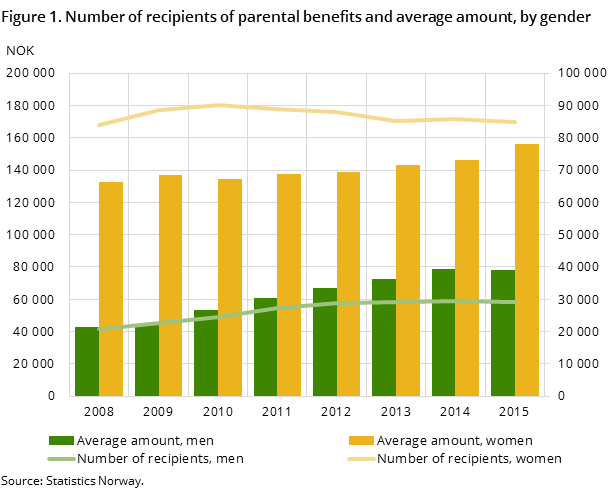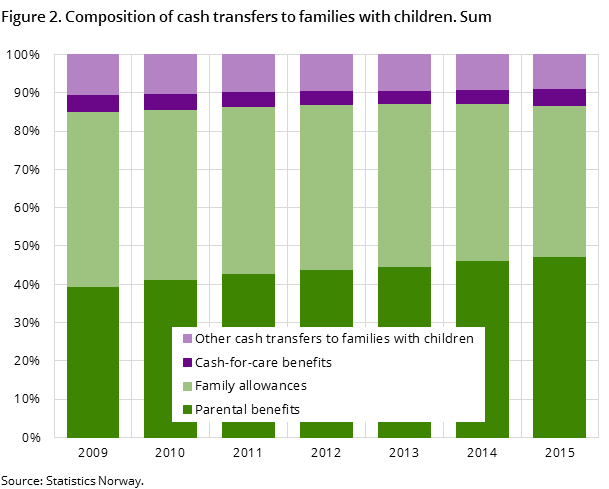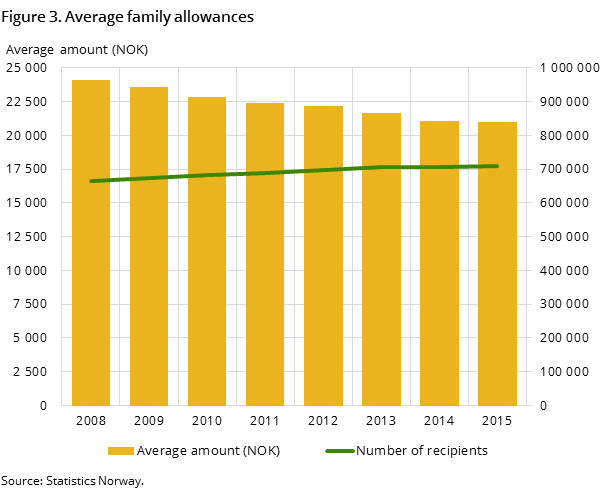Content
Published:
Men receive less parental benefit
Total cash transfers to families with children in Norway amounted to NOK 37.5 billion in 2015. Increased transfers of parental benefits and cash-for-care benefits contributed to a real growth of 1 per cent from 2014. After years of sustained growth, the transfers of parental benefits to men decreased in 2015.
| Recipients (persons) | Cash transfers (NOK mill.) | Percentage real change | ||
|---|---|---|---|---|
| 2014 - 2015 | 2009 - 2015 | |||
| 1Holiday pay from parental benefit on birth and parental benefit on adoption is not included. | ||||
| 2Municipal cash-for-care benefit is not included. | ||||
| 2015 | ||||
| Total cash transfers | 773 500 | 37 536 | 1.0 | 5.2 |
| Parental benefit on birth1 | 143 000 | 17 783 | 3.5 | 26.0 |
| Maternity grant on birth and adoption | 10 500 | 435 | 10.1 | -5.5 |
| Family allowances | 708 000 | 14 835 | -2.4 | -8.6 |
| Cash for care2 | 49 300 | 1 575 | 15.4 | -3.1 |
| Transitional benefit | 25 300 | 2 500 | -1.4 | -8.2 |
| Child care benefit | 25 400 | 360 | -4.7 | -24.4 |
| Education benefit | 3 300 | 48 | -9.6 | -20.7 |



Lower payments of parental benefits to men
Transfers of parental benefits on birth totalled NOK 17.8 billion in 2015. This is NOK 0.6 billion or 3.5 per cent more than in 2014 measured in fixed prices.
In recent years, transfers of parental benefits to fathers have increased, but this trend was reversed in 2015, as shown by figure 1. In fixed prices, the average payment of parental benefits to fathers fell by 1 per cent, while increasing by 6.6 per cent to mothers. The paternal quota was reduced from 14 to 10 weeks on 1 July 2014.
This decrease in received benefits to men is due to fathers taking somewhat shorter parental leave in 2015 compared to 2014. Figures from the Norwegian Labour and Welfare Administration (NAV) show that fathers took 47 days of parental leave on average in 2015, compared to 49 days in 2014. Mothers took 118 days of parental leave in 2015, up 5 days from the previous year.
The number of recipients of parental benefits has decreased by 1.2 per cent to 143 000 in 2015. By gender, the comparative figures are a decrease of 1.7 per cent for men, and a decrease of 0.8 per cent for women.
Increasing payments of cash-for-care benefits
Increased rates of cash-for-care benefits as of August 2014 contributed to the increase in the total payments of cash-for-care benefits of 15.4 per cent in 2015 measured in fixed prices. This increase was despite a slight decrease in the number of recipients from 50 600 in 2014 to 49 300 in 2015.
Payments of family allowances continue to fall, measured in fixed prices. The average payment of family allowance per beneficiary was NOK 21 000 in 2015; a slight decrease from 2014. The reason for this is that the nominal rates for family allowances have remained fixed for years. Figure 2 shows how family allowances over the last few years constitute an ever smaller part of total cash transfers to families with children, while parental benefits on birth make up an ever larger part.
Higher transfers per child in Oslo
Oslo is the county with the highest average payments of cash benefits per child in Norway in 2015, with NOK 41 300. This is partly because the number of births in Oslo is relatively higher than any other county in Norway. Parental benefit on birth is the benefit that gives the highest benefit per child. In Oslo, 23.3 per cent of people who received any kind of cash benefit to families with children received parental benefit, while the national figure is 18.5 per cent.
Other counties where the average payment of benefits is above the national average are Rogaland, Hordaland and Sør-Trøndelag. At the bottom is Hedmark, with NOK 29 300 per child, followed by Oppland, Telemark and Nord-Trøndelag, where the average payment per child is just over NOK 30 000.
The statistical basisOpen and readClose
The statistics are based on information from the Norwegian Labour and Welfare Administration (NAV) and the Norwegian Tax Administration. The data are more thoroughly described in “About the statistics”. All amounts in this article are measured in constant prices and thus adjusted for the changes in the consumer price index (CPI).
Change of rulesOpen and readClose
As of 1 April 2014, the supplementary child benefit for families living in Finnmark and Svalbard is discontinued. The transitional benefit for single parents will, as of 1 April 2015, be subject to income tax. This change concerns only new claimants as of 1 April 2015. Furthermore, the cash-for-care benefit is increased to NOK 6 000 per month for children aged 13 to 26 months. This amount is the same regardless of the age of the child.
Additional information
The statistics are based on information from the Norwegian Labour and Welfare Administration (NAV) and the Norwegian Tax Administration.
Contact
-
Statistics Norway's Information Centre
E-mail: informasjon@ssb.no
tel.: (+47) 21 09 46 42
